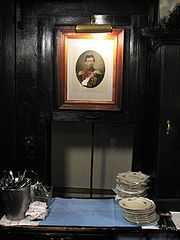Dumbwaiter (elevator)

Dumbwaiters are small freight elevators (or lifts) intended to carry objects rather than people. Dumbwaiters found within modern structures, including both commercial, public and private buildings, are often connected between multiple floors. When installed in restaurants, schools, kindergartens, hospitals, retirement homes or in private homes, the lifts generally terminate in a kitchen.[1][2]
The term seems to have been popularized in America in the 1840s, after the model of earlier "dumbwaiters" now known as serving trays and lazy Susans.[3] The mechanical dumbwaiter was invented by George W. Cannon, a New York inventor. Cannon first filed for the patent of a brake system (US Patent no. 260776) that could be used for a dumbwaiter on January 6, 1883.[4] Cannon later filed for the patent on the mechanical dumbwaiter (US Patent No. 361268) on February 17, 1887.[5] Cannon reportedly generated a vast amount of royalties from the dumbwaiter patents until his death in 1897.[6]
Description
A simple dumbwaiter is a movable frame in a shaft, dropped by a rope on a pulley, guided by rails; most dumbwaiters have a shaft, cart, and capacity smaller than those of passenger elevators, usually 45 to 450 kg (100 to 1000 lbs.)[2] Before electric motors were added in the 1920s, dumbwaiters were controlled manually by ropes on pulleys.[1]
Early 20th-century codes sometimes required fireproof dumbwaiter walls and self-closing fireproof doors and mention features such as buttons to control movement between floors and locks on doors preventing them from opening unless the cart is stopped at that floor.[7]
A legal complaint about a Manhattan restaurant's dumbwaiter in 1915, which also mentions that food orders are shouted up and down the shaft, describes its operation and limitations as follows:
[There is] ... great play between the cart of the dumb-waiter and the guides on which it runs, with the result that the running of the cart is accompanied by a loud noise. The rope which operates the cart of the dumb-waiter runs in a wheel with a very shallow groove, so that the rope is liable to and does at times slip off. ... The cart has no shock absorbers at the top, so that when it strikes the top of the shaft or wheel there is a loud report. ... [T]he ropes of the dumb-waiter strike such wall at frequent intervals with a loud report. ... [T]he dumb-waiter is often negligently operated, by running it faster than necessary, and by letting it go down with a sudden fall.[8]
More recent dumbwaiters can be more sophisticated, using electric motors, automatic control systems, and custom freight containers of other kinds of elevators.[citation needed] Recently constructed book lifts in libraries and mail or other freight transports in office towers may be larger than many dumbwaiters in public restaurants and private homes, supporting loads as heavy as 1000 pounds.[citation needed]
Regulations governing construction and operation
Building codes have regulated the construction and operation of dumbwaiters in parts of North America since the 19th century.[2] Modern dumbwaiters in the United States and Canada must comply with American Society of Mechanical Engineers (ASME) codes and, therefore, have features similar to those of passenger elevators.[9] The construction, operation and usage of dumbwaiters varies widely according to country.
References
- ↑ 1.0 1.1 George R. Strakosch (1998). The Vertical Transport Handbook. New York: John Wiley and Sons, 1998. ISBN 0-471-16291-4.
- ↑ 2.0 2.1 2.2 Harry Robert Cullmer and Albert Bauer (1912). Elevator Shaft Construction. New York: W.T. Comstock Company, 1912. p. 30. Limited Preview, Google Books, accessed August 26, 2008.
- ↑ Quinion, Michael. World Wide Words: "Lazy Susan". 24 Apr 2010. Accessed 11 Aug 2013.
- ↑ United States. Patent Office (1883). American Architect and Architecture, Volume 13. Boston: J. R. Osgood & Company, 1883. p. 11. Limited Preview, Google Books, accessed October 30, 2012.
- ↑ United States. Patent Office (1887). Official gazette of the United States Patent Office, Volume 39, Issues 1-4. Washington: Government Printing Office, 1887. p. 252. Limited Preview, Google Books, accessed October 30, 2012.
- ↑ J.H. Beers & Co (1897). Commemorative biographical record of Dutchess County, New York. Chicago: J. H. Beers & Co., 1897. p. 258., retrieved October 30, 2012.
- ↑ Anthony Avillo (2002). Fireground Strategies. Tulsa: PennWell Books, 2002. ISBN 978-0-87814-840-0.
- ↑ System, National Reporter; Superior Court (new York), New York (State); Court Of Appeals, New York (State); Supreme Court, New York (State); Company, West Publishing (1916). "DARR V. COHEN" (print and Web). New York Supplement, National Reporter System, New York (State) Superior Court (New York: West Publishing Company, 1916) 158 (c. 3): 325. Retrieved 2008-08-26. "Cases argued and determined in the Court of Appeals, Supreme and lower courts of record of New York State, with key number annotations." Via Google Books. (Original from the University of California. Digitized August 3, 2007.)
- ↑ See "ASME Product Catalogue". ASME. Retrieved 2008-08-26. ASME A17.1 covers safety for new elevators; A17.2, elevator inspection; A17.3, safety for existing elevators; and A17.4, emergency procedures, including those applying to modern dumbwaiters.
Further reading
- Stannah (The Stannah Group). "The Origins of a 'Dumb Waiter' or 'Dumbwaiter' ". Accessed August 26, 2008. (Cites performance rev. by Brown.)